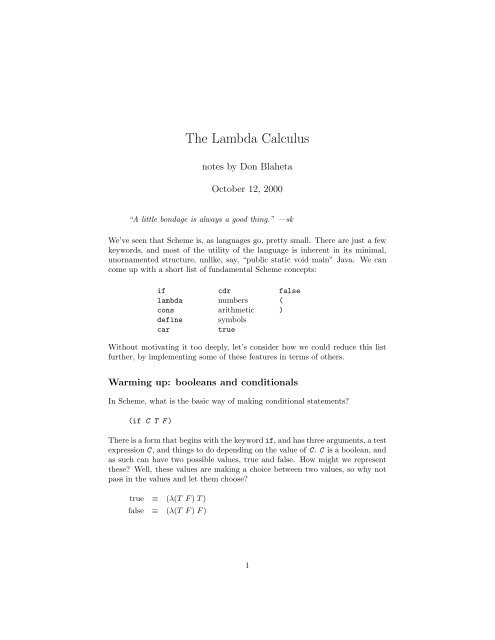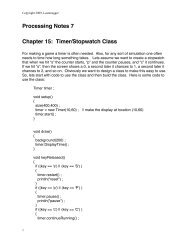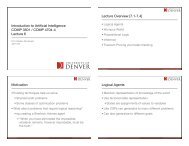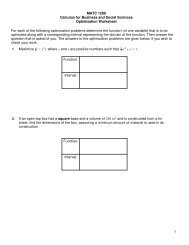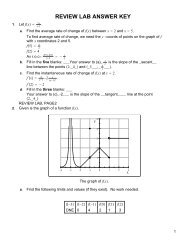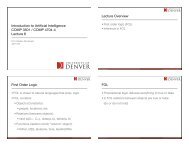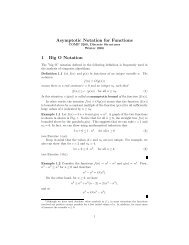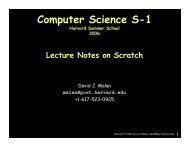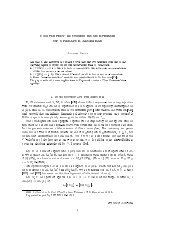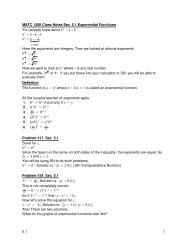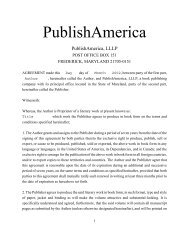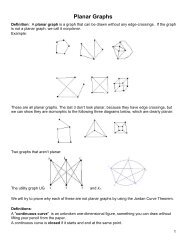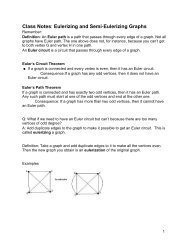You also want an ePaper? Increase the reach of your titles
YUMPU automatically turns print PDFs into web optimized ePapers that Google loves.
Thus true and false are functions with an arity 1 of 2 2 that select one or theother of their arguments. if then is simply(if C T F) ≡ (C T F), which applies its first argument to the other two. Note that for the usual ‘shortcircuiting’behaviour of if to work (and it is necessary, in order to properlyterminate recursion, avoid dividing by zero, etc.), evaluation must be lazy, thatis, we don’t actually evaluate an expression until we need its value, e.g. toperform arithmetic on it. Since we never need a value from the unused half ofthe conditional, we never try to evaluate it and the short-circuiting behaviouris preserved.We’ve thus eliminated if, true, andfalse from our list. Thus emboldened, wemove on toListsWhat, really, is a Scheme list? It’s a pair, with the first value of the pairrepresenting the first item of the list, and the second half of the pair containingthe rest of the list. To use standard LISPish terminology,(car (cons AB)) ≡ A(cdr (cons AB)) ≡ BSo how can we represent a cons? If we think in an object-oriented way for amoment 5 , we realise that a list, or a pair, is something that we want to feed twovalues into, and then be able to pass messages to in order to get those valuesback out. Well, we can feed two values in as arguments—(λ(a b)—and then return something that reads messages and uses them to act on thedata—(λ(m)(m ab))) .1 <strong>The</strong> “arity” of a function is simply a fancy word for the number of arguments it takes.Derived from ‘binary’, ‘ternary’, ‘n-ary’.2 We can simplify further and make λ only create functions of one argument by currying 3the arguments; for legibility and convenience we will not be doing this here.3 To ‘curry’ a function of n arguments, one makes a function of 1 argument that returns afunction of n − 1 arguments, repeating until n = 1 at which point you perform the calculationin the original n-ary function. Named after Haskell Curry 4 , who did much of the early workwith the process, though it was actually invented by a guy named Schönfinkel; presumably“schönfinkeling” was considered too unwieldy a term.4 A local—his parents were the founders of Curry College of Boston.5 Just make sure to wash your hands afterwards.2
Our messages m that we pass in obviously have to be functions, and since they’refed the two halves of the pair as arguments, they just pick one and return it:car ≡ (λ(a b) a)cdr ≡ (λ(a b) b)Just like true and false! This isn’t too surprising, though, since the structure isfairly similar: like conditionals, which select between two expressions to evaluate,the list operators are also selecting between two values (the halves of thepair).That removes cons, car, cdr from our list. Let’s move on to something a littlemore challenging.Something a little more challenging: NumbersFirst, a simplifying assumption: we will only deal with the set of natural numbers.That is, all integers not less than zero, or to put it more usefully, a naturalnumber is either zero or one plus a natural number.What is a number? A number is a count of stuff. It’s a number of things, it’sa number of sheep, it’s a number of whatever you want it to be. Such as...function applications? ConsiderN = 0 0 function applications| 1+N 1 more function application than NWhat function should we use? It doesn’t really matter. Pick something relevantto the task at hand.0 ≡ (λ(f) (λ(x) x))1 ≡ (λ(f) (λ(x) (fx)))2 ≡ (λ(f) (λ(x) (f (f x))))N ≡ (λ(f) (λ(x) (f N x)))This numeric representation is known as a “Church numeral” 6 . TogetaSchemenumber out of a Church numeral, just use add1 for f and 0 for x.Of course, numbers aren’t all that useful in and of themselves, until we cando things with them. Like the “succ” function, i.e. add1. It takes a Churchnumeral. What does it return? A Church numeral, which is starts with λf,then λx, and the actual result is f applied one more time:succ ≡ (λ(n) (λ(f) (λ(x) (f ((n f) x)))))6 Not an ecclesiastical appelation, but an honorary one—they are named after their discoverer,Alonzo Church, who was a contemporary of Curry, Schönfinkel, Turing, and that wholecrowd.3
number 0 is represented by zero function applications, so we need to pass ournumber a base case that starts out true, and a function that returns false if everapplied. Simply,zero? = (λ(n)((n (λ(dummy) false) true))Good, that knocks numbers and arithmetic off our list; there’s not much left:lambda define symbols ( )<strong>The</strong> parentheses aren’t going away, and symbols will be left as an exercise to thereader. That leaves define as the only thing not defined in terms of lambda;that is,What’s left? Recursion.Our first instinct is simply to define factorial asfact = (lambda (n)(if (zero? n)1(* n (fact (sub1 n))))), which (except for the symbols) we’ve now shown can be entirely reduced tolambdas. Problem is, it doesn’t work: fact hasn’t yet been bound when we useit in the last line. Well, we could dofact = (lambda (n)(if (zero? n)1(* n ((lambda (n)(if (zero? n)1(* n (fact (sub1 n)))))(sub1 n)))))ad nauseam, but of course that’s just postponing the problem. However, there isa pattern here, and we know what to do with patterns: lambda-abstract them.((lambda (mk-fact)...)(lambda (fact)(lambda (n)(if (zero? n) 1 (* n (fact (sub1 n)))))))5
So far, now, we’ve just assigned a name: we’ll call those last three lines mk-fact.What goes in the ...? Let’s first try something like(mk-fact ), which is to say, is something we don’t want to touch, if we do it’ll blowup. Well, if we can’t touch the bomb that the symbol fact is bound to, wecan’t do the recursive case—but we can do the base case. So (mk-fact )returns a function that correctly calculates the factorial of zero, with unspecifiedbehaviour if you pass it other stuff. Not very useful, but now consider(mk-fact (mk-fact ))First time through, fact is now bound to (mk-fact ), so if it tries to callfact the recursion actually works. But not very well, because that second timethrough, touching fact hits the . All the same, we now have something thatcorrectly calculates the factorial of both zero and one. Ultimately, this isn’t anydifferent than the version where we kept rewriting the entire function, but atleast it’s more succinct and compact.However. Consider what happens when we try(mk-fact mk-fact)That is, the entire thing looks like this:((lambda (mk-fact)(mk-fact mk-fact))(lambda (fact)(lambda (n)(if (zero? n) 1 (* n (fact (sub1 n)))))))<strong>The</strong> mk-fact in line 1 feeds its value to the two mk-facts in line 2; the secondof these becomes the value of fact in the function of lines 3–5, and this functionis itself bound to mk-fact. Nifty, we seem to have set up recursion. Of course,that last line won’t work, since fact (whose value is mk-fact) is expecting afunction, not a value like (sub1 n), so let’s feed it a function, like say fact.Meanwhile, we should rename fact since it is no longer a number-to-numberfunction, but a function-to-function function that makes a factorial function;how about a name like “mk-fact”?((lambda (mk-fact)(mk-fact mk-fact))(lambda (mk-fact)(lambda (n)(if (zero? n) 1 (* n ((mk-fact mk-fact) (sub1 n)))))))6
Mind-boggling. Why/how does it work? By making sure that anytime we areabout to “run out of function”, we make another one. Earlier, we noted that ifwe’re taking the factorial of zero, it doesn’t matter what the value of mk-factis— or anything else. And if we follow the recursive case, we run mk-factto generate a function that will do one iteration of fact. Inductively, it thenworks for all cases.Those last two lines are almost, but not quite, the pretty factorial function weall know and love, but that (mk-fact mk-fact) is ugly and doesn’t have muchto do with the actual factorial. We can abstract that out... and what to nameit? Why, fact, of course:((lambda (mk-fact)(mk-fact mk-fact))(lambda (mk-fact)((lambda (fact)(lambda (n)(if (zero? n)1(* n (fact (- n 1))))))(mk-fact mk-fact))))That is, (mk-fact mk-fact) is bound to fact, giving us exactly the previousversion. 9 But a further modification is desirable: lines 3–5 here are really themeat of the factorial calculation, while lines 1, 2, and 6 are all part of theinstrumentation of making the recursion work, and furthermore, those linescould be reused for other functions we want to be recursive. Thus we have thefunction(lambda (f)((lambda (x) (x x))(lambda (x) (f (x x)))))This function is known as Y ,ortheY -combinator, and it enables one to performrecursion in the lambda calculus. It obeys the equality(Y f) ≡ (f (Y f)), that is, it is a fixed point.9 Note that this crucially only works under lazy evaluation—otherwise the (mk-factmk-fact) would get evaluated once, get its value bound to fact, and that’d be the endof it, but we need fact to generate a new function each time through. In fact, the lambdacalculus always requires lazy evaluation; there is a parallel theory known as the lambda-valuecalculus in which eager evaluation is used. It is left as an exercise to the reader how to modifythe example so that it would work in an eager regime.7


